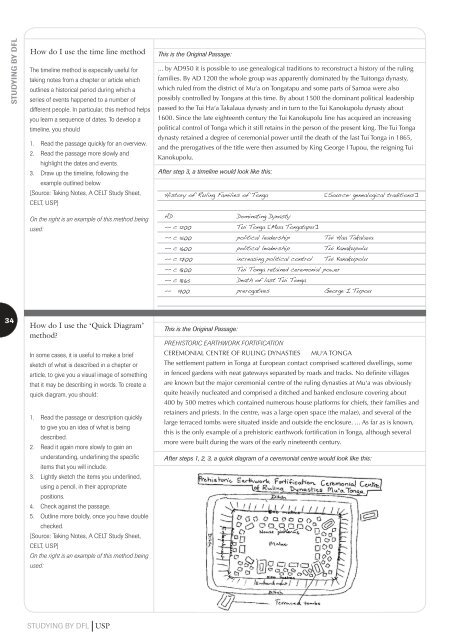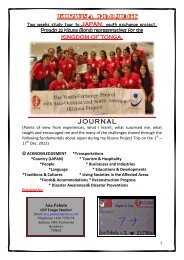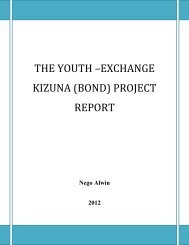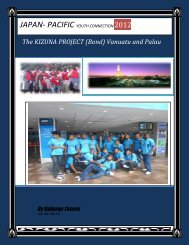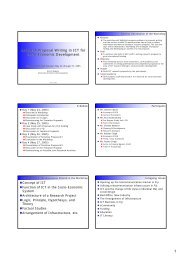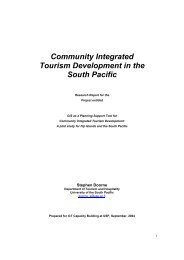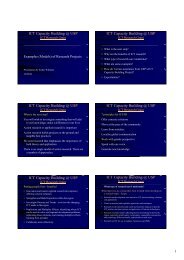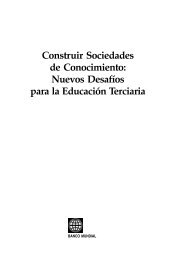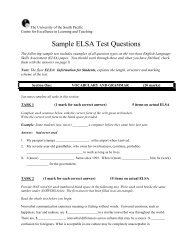our future, your future 2007 distance and flexible learning handbook
our future, your future 2007 distance and flexible learning handbook
our future, your future 2007 distance and flexible learning handbook
You also want an ePaper? Increase the reach of your titles
YUMPU automatically turns print PDFs into web optimized ePapers that Google loves.
STUDYING BY DFL<br />
How do I use the time line method<br />
The timeline method is especially useful for<br />
taking notes from a chapter or article which<br />
outlines a historical period during which a<br />
series of events happened to a number of<br />
different people. In particular, this method helps<br />
you learn a sequence of dates. To develop a<br />
timeline, you should<br />
1. Read the passage quickly for an overview.<br />
2. Read the passage more slowly <strong>and</strong><br />
highlight the dates <strong>and</strong> events.<br />
3. Draw up the timeline, following the<br />
example outlined below<br />
[S<strong>our</strong>ce: Taking Notes, A CELT Study Sheet,<br />
CELT, USP]<br />
On the right is an example of this method being<br />
used:<br />
This is the Original Passage:<br />
... by AD950 it is possible to use genealogical traditions to reconstruct a history of the ruling<br />
families. By AD 1200 the whole group was apparently dominated by the Tuitonga dynasty,<br />
which ruled from the district of Mu‘a on Tongatapu <strong>and</strong> some parts of Samoa were also<br />
possibly controlled by Tongans at this time. By about 1500 the dominant political leadership<br />
passed to the Tui Ha‘a Takalaua dynasty <strong>and</strong> in turn to the Tui Kanokupolu dynasty about<br />
1600. Since the late eighteenth century the Tui Kanokupolu line has acquired an increasing<br />
political control of Tonga which it still retains in the person of the present king. The Tui Tonga<br />
dynasty retained a degree of ceremonial power until the death of the last Tui Tonga in 1865,<br />
<strong>and</strong> the prerogatives of the title were then assumed by King George I Tupou, the reigning Tui<br />
Kanokupolu.<br />
After step 3, a timeline would look like this:<br />
History of Ruling Families of Tonga<br />
[S<strong>our</strong>ce: genealogical traditions]<br />
AD<br />
Dominating Dynasty<br />
-- c 1200 Tui Tonga [Mua Tongatapu]<br />
-- c 1500 political leadership Tui Haa Takalaua<br />
-- c 1600 political leadership Tui Kanakupolu<br />
-- c 1700 increasing political control Tui Kanakupolu<br />
-- c 1800 Tui Tonga retained ceremonial power<br />
-- c 1865 Death of last Tui Tonga<br />
-- 1900 prerogatives George I Tupou<br />
34<br />
How do I use the ‘Quick Diagram’<br />
method?<br />
In some cases, it is useful to make a brief<br />
sketch of what is described in a chapter or<br />
article, to give you a visual image of something<br />
that it may be describing in words. To create a<br />
quick diagram, you should:<br />
1. Read the passage or description quickly<br />
to give you an idea of what is being<br />
described.<br />
2. Read it again more slowly to gain an<br />
underst<strong>and</strong>ing, underlining the specific<br />
items that you will include.<br />
3. Lightly sketch the items you underlined,<br />
using a pencil, in their appropriate<br />
positions.<br />
4. Check against the passage.<br />
5. Outline more boldly, once you have double<br />
checked.<br />
[S<strong>our</strong>ce: Taking Notes, A CELT Study Sheet,<br />
CELT, USP]<br />
On the right is an example of this method being<br />
used:<br />
This is the Original Passage:<br />
PREHISTORIC EARTHWORK FORTIFICATION<br />
CEREMONIAL CENTRE OF RULING DYNASTIES MU‘A TONGA<br />
The settlement pattern in Tonga at European contact comprised scattered dwellings, some<br />
in fenced gardens with neat gateways separated by roads <strong>and</strong> tracks. No definite villages<br />
are known but the major ceremonial centre of the ruling dynasties at Mu‘a was obviously<br />
quite heavily nucleated <strong>and</strong> comprised a ditched <strong>and</strong> banked enclosure covering about<br />
400 by 500 metres which contained numerous house platforms for chiefs, their families <strong>and</strong><br />
retainers <strong>and</strong> priests. In the centre, was a large open space (the malae), <strong>and</strong> several of the<br />
large terraced tombs were situated inside <strong>and</strong> outside the enclosure. ... As far as is known,<br />
this is the only example of a prehistoric earthwork fortification in Tonga, although several<br />
more were built during the wars of the early nineteenth century.<br />
After steps 1, 2, 3, a quick diagram of a ceremonial centre would look like this:<br />
STUDYING BY DFL USP


